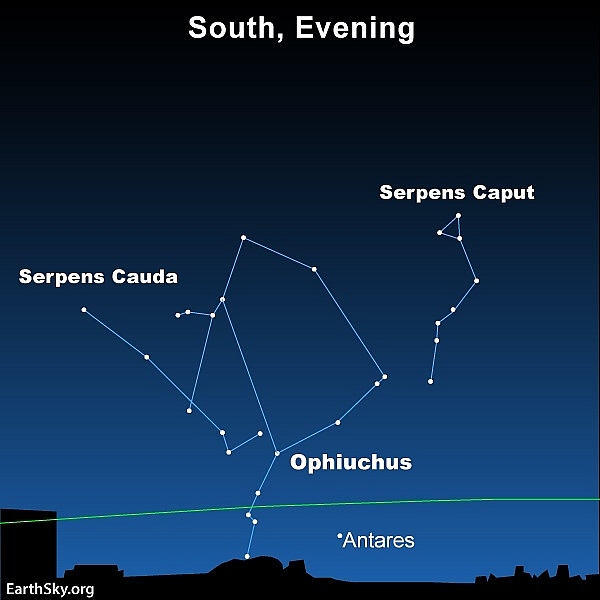OPHIUCHUS: Facts 13th Zodiac Star Sign With Dates, Symbols and Meaning
 |
| OPHIUCHUS is the new 13th astrological sign in the Zodiac |
NASA and 13th Zodiac Sign Ophiuchus
Originally there were 12 signs however an unearthed report from NASA has shocked some astrology enthusiasts.
NASA has unveiled a completely new zodiac sign, which means all of the other horoscopes have shifted.
It turns out that the Babylonians, who invented the zodiac signs more than 3,000 years ago, chose to intentionally ignore the the thirteenth zodiac sign, 'Ophiuchus' (which means 'serpent-bearer').
And now, because of the thousands of years which have passed since they were first devised, the sky has also shifted because Earth’s axis (the North Pole) doesn’t really point in the same direction anymore.
When the Babylonians first created the zodiac signs thousands of years ago, it was probably because they felt the changing positions of the constellations throughout the year was important to the people on Earth.
They divided the zodiac into 12 equal parts – which fit perfectly with their 12-month calendar based on the phases of the Moon.
But, as NASA explains, the Babylonians were aware at the time that 13 signs existed, not 12: "So the Babylonians picked one, Ophiuchus, to leave out."
They ignored that the Sun actually moves through 13 constellations, so they could assign the existing star signs an equal amount of time.
"Besides the 12 familiar constellations of the zodiac, the Sun is also aligned with Ophiuchus for about 18 days each year," NASA has clarified.
Ophiuchus: Birthday & Dates
Ophiuchus’ are born between November 29 and December 27. The star sign is associated with the snake bearer and is nestled between Scorpio and Sagittarius.
What Is Ophiuchus: Symbols and Meaning
A recently discovered constellation has thrown astrologers for a loop and confused astro enthusiasts about how this might change their sun sign and birth chart. Let us introduce you to Ophiuchus, the “newest” zodiac sign.
Ophiuchus is a large constellation on the celestial equator, between the constellation Scorpius and Sagittarius. For that reason, it is considered a potential thirteenth zodiac sign. Ophiuchus comes from the Greek word Ophioukhos—which translates to “serpent-bearer.” That may be the reason this sign is represented as a man (or woman) grasping a snake.
While the other signs are based on mythological characters and figures, Ophiuchus is named after a real person. Ophiuchus is named after Imhotep, an Egyptian chancellor of the Pharaoh Djoser, and the high priest of the Ra, the sun god. While little is known about Imhotep’s actual life, he is often equated to Asclepius, the Greek god of medicine. (Fun fact: The “rod of Asclepius,” a snake entwined staff, remains a symbol of medicine today.)
Is Ophiuchus a Real Zodiac Sign?
It’s not like Ophiuchus just magically showed up in the sky one day (though it may feel like it did). Ancient astrologers may have overlooked Ophiuchus for various reasons, now lost to the ages. Whatever the reason, Ophiuchus is an old constellation that is new to us.
But now you’re probably wondering, “How does this discovery even happen? Can you really just make a new zodiac sign?” And that’s totally fair! To be clear, even though this constellation is technically between Scorpio and Sagittarius, astrologers do not consider it as part of the zodiac wheel. That’s right, disregard! Ophiuchus is not a real zodiac sign in the eyes of astrologers.
 OPHIUCHUS: Just A Constellation, Not The Zodiac Sign? OPHIUCHUS: Just A Constellation, Not The Zodiac Sign? OPHIUCHUS 13th Zodiac Sign shares the same characteristics and Predictions as Sagittarius. |
New Star Sign Dates for 13 Zodiac Signs?
Ophiuchus is unique in many ways. But one difference is that it has a much shorter sun cycle than the other 12 zodiac signs. While it takes the sun thirty days to move through one zodiac sign, it only takes the sun 18 days to move through Ophiuchus: from November 29 to December 17.
While this can come as quite a shock to Sagittarius natives, don’t think you’re out of the woods just yet. If the thirteenth zodiac sign is added to the wheel, all signs would have new dates—meaning many sun signs would change.
These are the new dates of the 13 star signs including Ophiuchus:
Capricorn: January 20 to February 16
Aquarius: February 16 to March 11
Pisces: March 11 to April 18
Aries: April 18 to May 13
Taurus: May 13 to June 21
Gemini: June 21 to July 20
Cancer: July 20 to August 10
Leo: August 10 to September 16
Virgo: September 16 to October 30
Libra: October 30 to November 23
Scorpio: November 23 to November 29
Ophiuchus: November 29 to December 17
Sagittarius: December 17 to January 20
Ophiuchus: Personal Traits
Ophiuchus as their star sign are said to have a mixture of traits from Scorpio and Sagittarius, the star signs which sandwich the new house.
They are described as insightful and curious, and seekers of wisdom and knowledge, open to change and easily bored with routine.
 |
| If you’re in the Northern Hemisphere, look southward on July or August evenings for mighty Ophiuchus |
However, we can’t leave out Scorpio, as Ophiuchus, the constellation is located between Scorpio and Sagittarius. So, this snake-handler may take on the traits of the scorpion, like their mysterious nature (obviously), jealous tendencies, and temper flares. Rest assured, you don’t want to mess with them.
Lastly, it’s interesting to look at what Ophiuchus’ name is connected to—the god of medicine. Ophiuchus natives are our healers, herbalists, and caretakers. Somebelievethat people born under this sign are healing witches. They may have a vicious bite (like a snake) but they are caretakers to the core.
While not much is known about the element associated with Ophiuchus, some astrologers speculated that it may be associated with the fire element because Ophiuchus is “a go-getter and a doer, and it’s also described as passionate.” These are all the qualifications of a fire sign.
Ophiuchuses are prone to jealousy, can be short tempered, and are great at procrastinating when they’re not being restless and critical.
Ophiuchus in history and scienceIt’s been more than 400 years since anyone has seen a supernova explosion of a star within our own Milky Way galaxy. But in the year 1604, a supernova known as Kepler’s Supernova exploded onto the scene, attaining naked-eye visibility for 18 months. It shone in southern Ophiuchus, not all that far from the Pipe Nebula. Kepler’s Supernova in 1604 came upon the heels of Tycho’s Supernova that lit up Cassiopeia in 1572. These supernovae sent shock waves into the intelligentsia of Europe, which firmly believed in the Aristotelian notion of an immutable universe outside the orbit of the moon. Tycho Brahe took a parallax measurement of the 1572 supernova, proving that it could not be an atmospheric phenomenon. In fact, the supernova shone well beyond the moon’s orbit. Shortly thereafter Kepler’s Supernova in 1604 seemed to drive home the point all over again. Moreover, Tycho Brahe measured the distance of a comet in 1577, also finding it to be farther away than the moon. Aristotelians wanted to believe comets were gases burning in the atmosphere, but once again, Tycho threw cold water on the idea of Aristotle’s immutable universe. |


























